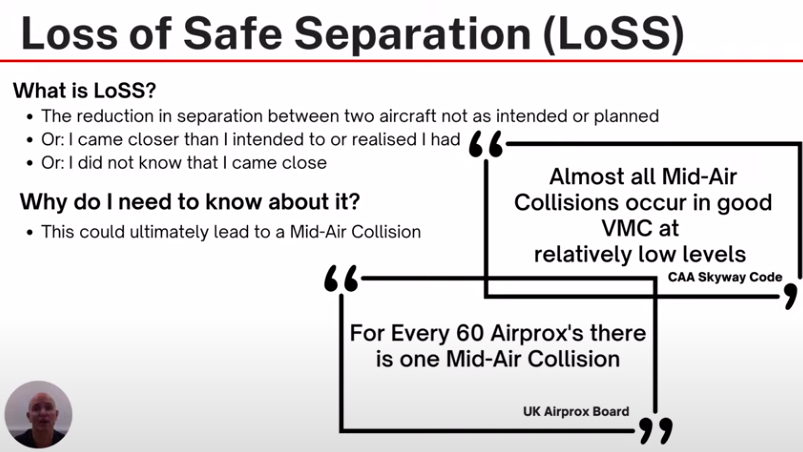Safety First: Reflections From Attending a ‘Loss of Safe Separation’ Webinar – By Mike Ling
Written by: The Proficient Airman, Mubashar Yasin.
Attending a ‘Loss of safe Separation’ Webinar – Mike Ling
I attended a virtual webinar presentation hosted by Mike Ling at Astral Aviation consulting working in partnership with the CAA with their safety campaign. They offer resources and presentations like these that I think are really useful and aviators can benefit from. One of their core safety objective is to promote a ‘just’ culture through open, transparent communications to encourage reporting and discussions.
Below are the notes I made from the webinar surround /loss of safe separation’. First here is the overview of what we covered throughout the webinar:

Loss of safe separation
Loss of separation is the unintended reduction in separation between two aircrafts. This could lead to mis-air collision of aircrafts. This is also known as airprox. In 2019, the UK Airprox Board annual report has reported there was on average 6 incidents a week – almost one a day!

Fatal incident involving a Cessna 172 and Guimbal Cabri G-2 helicopter
I remember this incident like it was yesterday. A fatal incident involving a Cessna 152 (G-WACG) and the Guimbal Cabri G-2 (G-JAMM) helicopter took place mid-air in Aylesbury, England.
Both aircrafts took off from my local airfield – just 5 minutes down the road from me. I have regularly seen G-WACG fly over my house on approach to the airfield. The Cessna took off from Booker Aviation with a Bucks University student and instructor on board. The collision occurred 14 minutes after take-off from Wycombe.
The accident occurred in Class G airspace with not air traffic control (ATC) service being provided. The Cessna was conducting a glide-descent exercise from 4,000ft. It is believed the Cessna glided onto the helicopter.
The opportunity for either to identify each other was restricted. They were both following a similar track and were outside the scope of each other’s view. As a result this led to a fatal mid-air collision between both aircrafts.
What can we do to avoid mid-air collision occurring?
One way is to incorporate electronic conspiguity devices that are compatible to the airfield. This will help pilots be more aware of what is occurring in the airspace surrounding them. Such devices were not available in the cockpit at the time of the crash.
Another option is to operate in ATC areas in order for them to assist you through airspace you may be unfamiliar with. It is also important to weave every so often to ensure you are clear from other aircrafts.
What are the common causes of airproxes?
- ATC situational awareness – poor communication with aircraft-ATC. Perhaps when pilots don’t request a service or request a sub-optimal service that leads to an ineffective response that is outside the scope of what the pilot requires.
- Pilot situational awareness – lack of communication; lack of electronic means to communicate. This may be a result of poor planning or distraction in the cockpit (human factors)
- Tactical planning and execution – poor ability to adapt flight plans in flight in light of changing circumstances. Ensure to have a plan B in mind or take time to sketch an alternative plan ahead of changing circumstances.
- Electronic Warning System Operation and Compliance – On board warning systems were absent or ineffective due to incompatibility (in 69% incidents reported – 2019). Compatible electronic conspiguity devices offer an easy solution to prevent such instances and should be adopted in aircrafts when flying.
- See and avoid – only effective in 42% of incidents in 2019. This may be because of poor visibility or limitations that lead to late sighting of an aircraft. Another reason may be distractions through prioritising steady, level flight or another aspect that takes priority. It is important to constantly scan outside the cockpit and when looking at instruments – to have a quick glance over them. Never become fixated on the instruments in the cockpit for more than 2 seconds. Fly the plane!
What makes an effective ‘Lookout Scan’?
- 80% looking out the cockpit and 20% inside at the instruments
- Break up the lookout areas into: centre, left and right
- Focus and stabilise: when scanning each area – stabilise your eyes on an object for 1 second at a time then move to the next.
- Glance over the instruments then look back outside again.
Preventing an Airprox?
This involves 3 words. Prepare, Plan and Perform.

Prepare
- Have I left enough time to prepare for my flight?
- Is there anything ‘new’ to my flight?
- Is the weather suitable, will it pose an issue?
- Is the aircraft airworthy and how do I check?
- Did something not go as expected last time and what do I do differently this time?
- IMSAFE checklist: illness, medication, stress, alcohol, fatigue and eating – check through each of these and question whether each one will pose a risk to flying
Plan
- Have I allowed enough time to plan my flight?
- Where am I flying today? My plan?
- Is my equipment up to date?
- Is the weather in accordance with my plans?
- Have I checked the airspace? – horizontal and vertical.
- Are there areas of increased activity – unfamiliarity, chokepoints or Nav beacons?
- Air traffic service – who do I call? The correct frequency? What level of service do I need? Have I considered any contingencies?
- Should I be flying today?
Perform
- Sound preparation and plan will lead to a good performance
- Rehearse – rehearse a flight and potential challenges – e.g. approaching traffic or if I have engine failure and what do I do? Sit in an chair and rehearse through these scenarios.
- Prioritise – know what the most important aspect of your flight is – e.g. listening attentively to radio calls or being cautious of high traffic in proximity planned.
After-flight
Reflect on the flight after the flight to help you improve on the next flight.
- What went well?
- What could I have done better?
- Was I prepared?
- Was my airborne work cycle – prepare, plan and perform effective?
- What issues was there on this flight and what lessons can I learn?
- Could my mistake jeopardise the safety of others and how do I report it? Did I act responsibly?
- Am I proud of my flight and why?
- Did I do my best?
This session was a fantastic lesson around LoSS and the important actions to avoid such near-miss or fatal incidents in the future. One of the key take-aways for me was the enormity of situational awareness and being a pilot who is actively FLYING the plane and not someone who is sat in a seat controlling the pedals. Being aware of your surroundings is incredibly important and we should always be ready to respond quickly as well as taking preventative measures to maintain safety at all times.
Happy flying.
